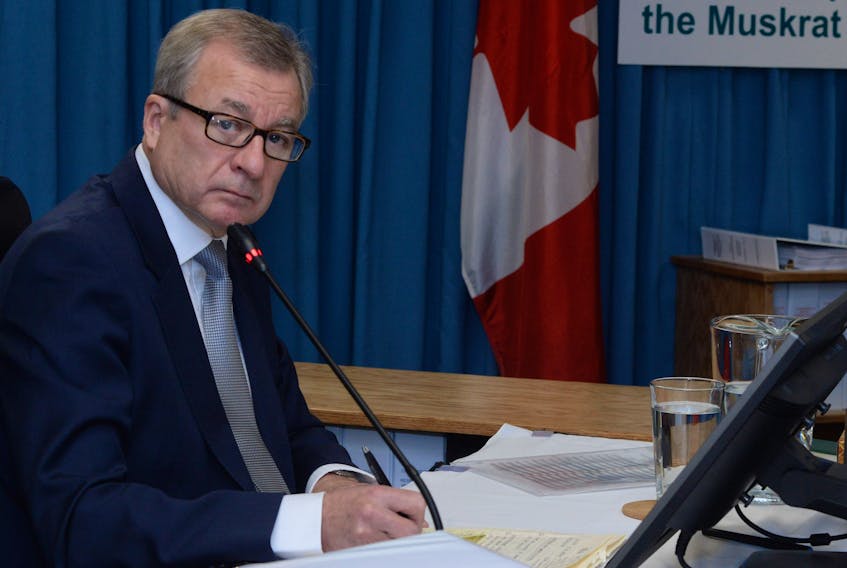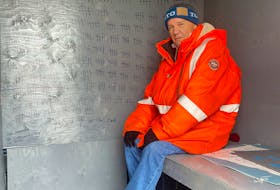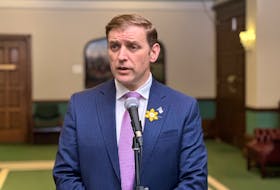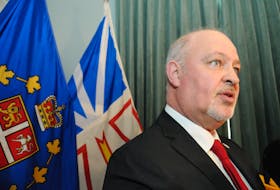ST. JOHN'S, N.L. — At the Muskrat Falls Inquiry on Friday, after more than 20 minutes of rapid-fire questions, lawyer Peter O’Flaherty asked Muskrat Falls project director Paul Harrington if it was fair to say he intentionally obstructed the government’s oversight committee and consultant EY.
There was a focus during the questions on EY’s contract with the Liberal government to review cost and schedule — to help “open the books” on Muskrat Falls — as Premier Dwight Ball and Natural Resources Minister Siobhan Coady promised in December 2015.
O’Flaherty represents Ball and Coady, who both have standing at the inquiry as individuals.
“I’ve shown you the evidence here, and you’ve said that’s not what you’re doing. But why should the commissioner accept any other inference except that is exactly what you were doing — delaying and obstructing this work?” O’Flaherty asked.
“Well, that’s up for the commissioner to decide,” Harrington said.
At no point did the project director agree with the over-arching claim he obstructed oversight.
O’Flaherty raised different points, each met with responses from Harrington along the way.
Early on, the lawyer asked the project director to confirm he was aware of the government’s commitment to “open the books.”
Harrington said he was.
“And I put it to you then, sir, that it was the responsibility of Nalcor and you, as the project director of this important project, to participate and support this review, correct?” he asked.
“We did,” Harrington replied, denying any inappropriate actions.
Harrington said he had responsibility to participate in the review process. He said he was aware of the public concern around the project’s cost and schedule, given where cost increases were driving electricity rate forecasts.
“Giving them that information and those answers, that’s what this review was about, wasn’t it?” O’Flaherty asked.
Harrington agreed.
The lawyer asked why, with the importance of the review established, Harrington would have walked out of a meeting with EY. He asked why he would say the consultant was “ill prepared” and delay work with EY.
Harrington has said he was busy as the project director, caught off guard by the approach to the particular meeting, and he didn’t want to sit for questions he wasn’t prepared to answer.
O’Flaherty asked why he would have sought a non-disclosure agreement (NDA) between Nalcor and EY as the review got underway.
Harrington said he only asked if it was needed. He said Nalcor vice-president Gilbert Bennett decided it was. Bennett signed the final agreement.
“I’m going to put it to you, Mr. Harrington, that neither you nor Mr. (Gilbert) Bennett, who will testify here, nor Mr. (Ed) Martin, had any authority to demand a NDA from any independent body appointed by government which already had a full suite of confidentiality provisions in place,” O’Flaherty said. “That was none of your business to get involved in that, sir.”
Harrington responded, without missing a beat.
“Then someone should have told me it’s none of your business,” he said. “They didn’t.”
They moved on.
“There have been a number of obstacles to timely receipt of data: NDA signing, competing priorities at Nalcor, delayed requests for clarification/justification, document release process,” EY stated, in a report at the end of January 2016.
Harrington said there had been the Christmas period, when contractors scattered. He wasn’t even in the country. Then, Nalcor had to get information from the returning contractors and transfer it in digital data rooms.
As for where the non-disclosure agreement idea came from, he made reference to a meeting in the premier’s office — one including EY — on Jan. 7. 2016. He said he took from that meeting the message he was to be particularly cautious with information on project contractor Astaldi.
His notes include bullet-point summaries of messages attributed to the premier: “Stress commercial sensitivity – Esp. Astaldi that cannot be compromised,” it reads.
O’Flaherty asked if Ball gave any direction on a non-disclosure agreement, or on Nalcor holding back on Astaldi data.
“Not explicitly,” Harrington said.
Emails on record show a difficult relationship between EY, Harrington and others at Nalcor. EY project management expert Michael Kennedy testified about the contractor’s team having difficulties, and feeling “managed” by Nalcor.
“It felt like they were being very careful with what they were sharing with us,” Kennedy said.
RELATED STORIES









